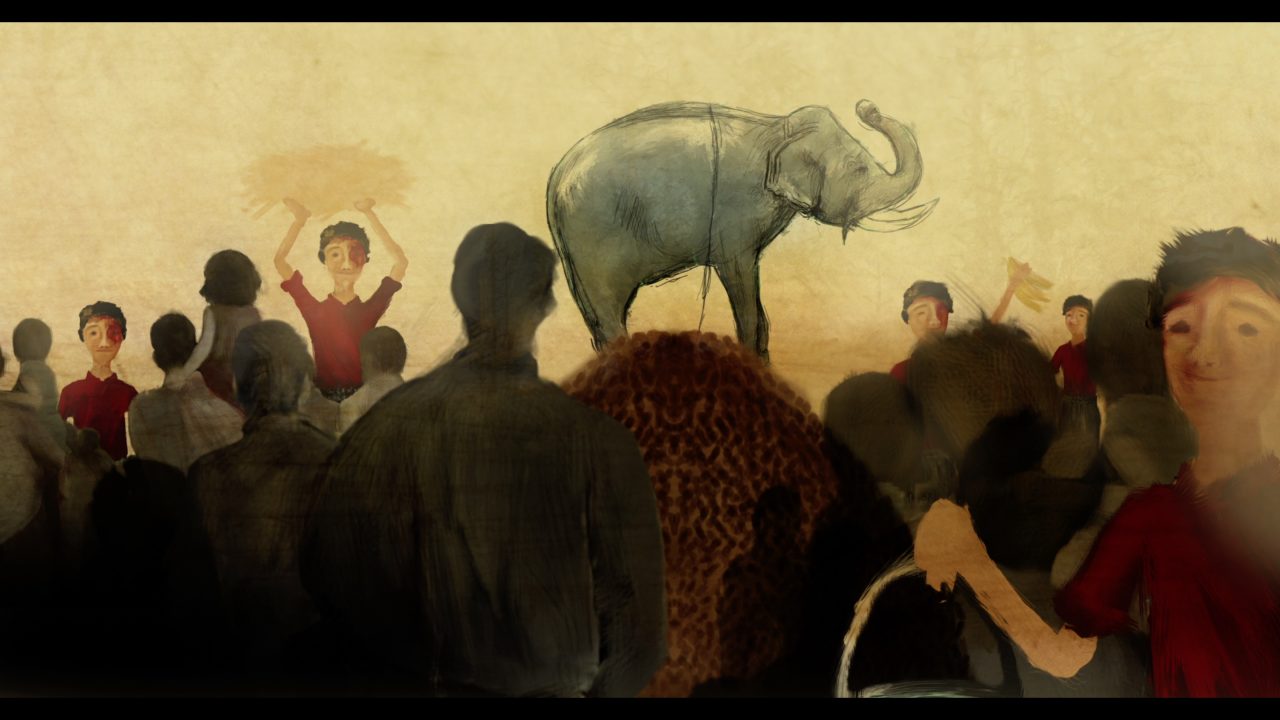
Mini-Lesson for Balakrishna
Mini-Lesson for Balakrishna
Develop empathy for elephants with STEAM and social media
Themes: Ethics, English Language Arts, Media Education, Science and Technology
Ages: 12–14
Balakrishna, Colin MacKenzie & Aparna Kapur, provided by the National Film Board of Canada
Keywords/Topics: Animal Welfare, Responsible Citizenship, Captivity, Empathy, Respect, Injustice
Guiding Question: How can our relationships with animals impact the way we see the world?
Summary: The short film Balakrishna tells the story of a 13-year-old boy named Winton Cook who develops a powerful relationship with an elephant named Balakrishna. In 1967, the bull elephant is brought to East River, Nova Scotia, as the “lucky charm” of an Indian businessman who’s promoting the opening of his factory. Winton is fascinated with the majestic elephant and soon starts giving Balakrishna clean water, hay, and bananas. He befriends the elephant’s handler, Sankunni, and even creates a dictionary of key words so that he can communicate with him. As winter approaches, it becomes clear that there’s no plan to properly care for Balakrishna, and sadly, the elephant is not able to survive in the cold weather. Winton is horrified by how Balakrishna was treated, and his death haunts him for the rest of his life.
In the following activities, discover the powerful connection that Winton has with Balakrishna and use your own experiences with animals to inspire a variety of final products. Use art to communicate emotions, use the STEAM design process to create an elephant sanctuary, and speak out in support of animal rights using social media.
Activity 1) Creatively representing our relationships with animals
In this activity, watch a clip and evaluate your feelings about animals in addition to empathizing with the elephant in the film. Draw on your experiences or the experiences of others in order to apply the creative process and communicate your feelings in a final art product.
Questions for viewing:
- How did you feel when you saw the elephant for the first time? What did you notice about the elephant’s behaviour?
- How would you describe Winton’s initial feelings about the elephant? How does the filmmaker communicate his feelings using images and audio?
- In the second clip, Winton has a strong emotional reaction to his experience. How did this event affect his feelings toward Balakrishna?
Art activity:
- Describe a meaningful relationship that you’ve had with an animal in your life, or research a famous relationship between a human and an animal of any species. Using technology or mixed media, create an art piece that communicates what each partner gets out of the relationship. Be mindful of the use of space, colour, texture, shape and form to represent different emotions.
Go Deeper
The relationship between humans and service animals, such as seeing-eye dogs, is often highlighted in the media. How has the use of service animals evolved over time? Examine the relationship between animals and humans over the past century and create a timeline slideshow to explain how the role has changed and why.
Activity 2) Using technology to help elephants
In the film, the residents of East River speak out to try and protect Balakrishna from the cold Nova Scotian winter, but do they really know what an elephant needs? Research elephant habitats and determine what the community would need to provide a fulfilling, safe, and healthy environment for Balakrishna to thrive in. You have an unlimited budget to use any reasonable technology that currently exists. Think about the basic physical and emotional needs of an adult elephant, as well as climate, vegetation, etc. Using other elephant sanctuaries in the world as an example, answer the question: What’s needed to keep an elephant alive and happy outside of its natural habitat?
Go Deeper
After designing a blueprint for the habitat, use a 3D design program like Tinkercad or Vectary to create the sanctuary that would house the elephant. For a math class related activity, educators can ask students to estimate the cost of the habitat and create a plan to sustain an elephant population in the future.
Activity 3) Speaking up for animals on social media
Warning: This clip contains some content that may be disturbing. It is worth having a discussion as a class prior to watching it, to ensure students are prepared for the depiction of an elephant’s tusk with blood, as well as the footage of the elephant’s bloody body being set on fire.
In 1967, many residents of East River wrote to the local newspaper to express their outrage at the treatment of Balakrishna. Times have changed, and most people would not turn to their local newspaper to voice complaints. How do people report wrongdoings or abuses in society today? Have students create a modern reaction to Balakrishna’s treatment using the app or social media platform of their choice.
Go Deeper
The practice of keeping elephants in captivity in zoos has come under criticism in recent years. African Lion Safari in Ontario has come under fire for continuing to allow elephant rides. Bob Barker, the former game show host, petitioned to have three elephants moved from the Toronto Zoo to an elephant sanctuary in California. Read about these events and find arguments that either support or refute the claim that elephants should not be kept in captivity. Create a persuasive video or photo essay to encourage or discourage the practice.
Link 1: Elephant rides at African Lion Safari ‘disturb’ animal welfare advocates (June 25, 2019)
Link 2: The long goodbye of the Toronto Zoo elephants (October 12, 2013)
Link 3: ‘Giving them something natural’: Toronto Zoo elephants find happy retirement in California (February 13, 2017)
Melissa Johnston teaches Grade 5/6 Extended French for the Toronto District School Board. Over the past nine years, she has integrated technology, media, and social justice into her teaching across all subjects in the junior and intermediate grades. She loves inspiring students to take risks in their learning and to question the status quo. Melissa has a degree in Journalism from Ryerson University and is a specialist in French as a Second Language.
Pour lire cet article en français, cliquez ici.
Discover more Mini-Lessons | Watch educational films on NFB Education | Watch educational playlists on NFB Education | Follow NFB Education on Facebook | Follow NFB Education on Pinterest | Subscribe to the NFB Education Newsletter



